Results 1-8 of 8
<<< Previous 1 Next >>>
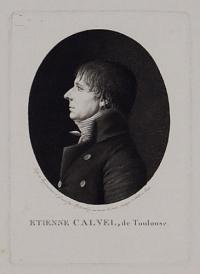
Etienne Calvel, de Toulouse
Dess au Physionotrace et gravé par Quenedey rue des petits Champs No.1284 a Paris
Etching and aquatint with large margins, platemark 130 x 90mm (5 x 3¾"). Good impression.
French author Etienne Calvel, made by Edme Quénedey (1756 - 1830), a miniature painter and engraver, who made much use of the physionotrace. This was a mechanised drawing instrument that could reproduce the outline profile of a portrait. It was invented by Gilles-Louis Chretien, who engraved Quenedey’s portraits from 1787 to 1789, in 1786. Chretien and Quenedey founded a very successful portrait studio in Paris together in 1788. Between 1786 – c.1810 there were only two studios in Paris which produced a relatively small number of physionotrace engravings. Consequently very few of these intriguing portraits are preserved today. Because of their origins and the realism physionotrace portraits have, they can be seen as true photo-graphic objects and are therefore classified as a forerunner of photography.
[Ref: 35222] £180.00
(£216.00 incl.VAT)

Dalayrac.
Dess: au Physionotrace et Gravé par Quenedey rue neuve des petit-champs no.15 à Paris, 1809.
Se vend chez Quenedey rue neuve des Petits Champs No.15 a Paris. Dep. a la Bib Imp.
Etching and aquatint with small margins, platemark 250 x 195mm (9¾ x 7¾"). On watermarked laid paper; creases.
Portrait of French composer Nicolas-Marie d'Alayrac, known as Nicolas Dalayrac (1753 - 1809), best known for his opéras-comiques; bust-length, turned to right, with short grey hair, earring, and decoration pinned to jacket. By Edme Quénedey (1756 - 1830), miniature painter and engraver, who made much use of the physionotrace, a mechanised drawing instrument that could reproduce the outline profile of a portrait. It was invented by Gilles-Louis Chretien, who engraved Quenedey’s portraits from 1787 to 1789, in 1786. Chretien and Quenedey founded a very successful portrait studio in Paris together in 1788. Between 1786 – c.1810 there were only two studios in Paris which produced a relatively small number of physionotrace engravings. Consequently very few of these intriguing portraits are preserved today. Because of their origins and the realism physionotrace portraits have, they can be seen as true photo-graphic objects and are therefore classified as a forerunner of photography. See BNF FRBNF39603944.
[Ref: 35219] £340.00
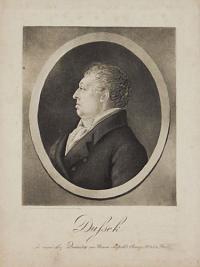
Dussek
Dess au Physionotrace d'après le Buste de feu Callamard et grave par Quenedey.
Se vend chez Quenedey rue neuve des Petits Champs No.15 a Paris.
Etching and aquatint with small margins, platemark 250 x 195mm (9¾ x 7¾"). Slightly stained.
Jan Ladislav Dussek (1760-1812), pianist and composer. Born in Cáslav (now part of the Czech Republic), Dussek travelled widely across Europe as a young man. In Paris, he performed before Marie Antoinette and made the acquaintance of Napoleon, before fleeing to England at the time of the French Revolution. He spent eleven years in London working as a piano teacher and giving concerts, appearing with Haydn when the latter visited London. He then lived in Prussia before accepting a position with the politician Talleyrand to spend his final years in France. By Edme Quénedey (1756 - 1830), miniature painter and engraver, who made much use of the physionotrace, a mechanised drawing instrument that could reproduce the outline profile of a portrait. It was invented by Gilles-Louis Chretien, who engraved Quenedey’s portraits from 1787 to 1789, in 1786. Chretien and Quenedey founded a very successful portrait studio in Paris together in 1788. Between 1786 - c.1810 there were only two studios in Paris which produced a relatively small number of physionotrace engravings. Consequently very few of these intriguing portraits are preserved today. Because of their origins and the realism physionotrace portraits have, they can be seen as true photo-graphic objects and are therefore classified as a forerunner of photography.
[Ref: 35220] £260.00
(£312.00 incl.VAT)
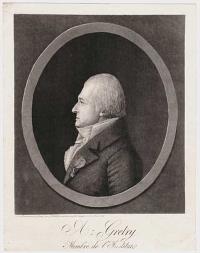
A: Gretry. Membre de l'Istitute.
Dess. au Physionotrace et Gravé par Quenedey rue neuve des petits champs no.15 à Paris 1808.
[Se vend chez Quenedey rue neuve-des-Petits-Champs No.15 à Paris'. Dep. à la Bib. Imp.]
Aquatint with etching. Sheet 225 x 175mm (8¾ x 6¾"). Trimmed within plate, losing publication line.
Profile portrait of André Grétry (1741-1813), Belgian composer of opéras comiques. Frenchman Gilles-Louis Chrétien invented the 'physionotrace' in the 1780s to draw the outlines of silhouettes, which were then completed by the artist and transferred to aquatint printing plates using another pantograph. The published of this print, Edme Quenedey, was Chrétien's first business partner: a drawing he made of the device in 1788 is now in the Bibliothèque Nationale de France..
[Ref: 62402] £220.00
(£264.00 incl.VAT)
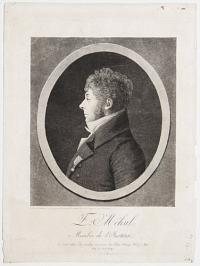
E: Méhul. Membre de l'Institute.
Dess. au Physionotrace et Gravé par Quenedey rue neuve-des-petits-champs no.15 à Paris 1808.
Se vend chez Quenedey rue neuve-des-Petits-Champs No 15 à Paris / Dép. à la Bib. Imp.
Aquatint. 245 x 190mm (9½ x 7½"). Some minor staining.
Étienne Nicolas Méhul (1763-1817), composer influential in the development of French opera. A physionotrace is an instrument designed to trace a person's profile, invented by a Frenchman named Gilles-Louis Chrétien in 1783–84. Chrétien's device transmitted the tracing of the silhouette, whilst crucially also including details such as clothing, to an engraving needle via an eyepiece. Enabling the production of multiple and therefore cheap copies, the physionotrace represented a precursor to photography in making portraiture a mass phenomenon. See Ref: 17260.
[Ref: 46257] £190.00
(£228.00 incl.VAT)
![[Antonio] Sacchini.](img-thumbnail/jpegs/62403.jpg)
[Antonio] Sacchini.
Dess. au Physionotrace d'ap. le buste et Gravé par Quenedey rue neuve des petits champs no.15 à Paris [n.d., c.1808].
Se vend chez Quenedey rue neuve-des-Petits-Champs N.º 15 à Paris'. Dép. à la Bib. Imp.]
Aquatint with etching. 250 x 190mm (9¾ x 7½"), with very large margins.
Profile portrait of Antonio Maria Gasparo Gioacchino Sacchini (1730-1786), Italian composer of operas. Frenchman Gilles-Louis Chrétien invented the 'physionotrace' in the 1780s to draw the outlines of silhouettes, which were then completed by the artist and transferred to aquatint printing plates using another pantograph. The published of this print, Edme Quenedey, was Chrétien's first business partner: a drawing he made of the device in 1788 is now in the Bibliothèque Nationale de France..
[Ref: 62403] £180.00
(£216.00 incl.VAT)
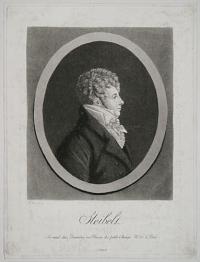
Steibelt.
E Quenedey.
Se vend chez Quenedey rue Neuve des petits Champs No.15 à Paris. Déposé.
Rare Aquatint. Plate 250 x 186mm. 9¾ x 7¼". Some rubbing.
Daniel Steibelt (1765-1823) was a German pianist and composer. He started studying music until his father forced him to join the Prussian army, which he later deserted to begin a nomadic career as a pianist before settling in Paris. He eventually began to split his time between Paris and London, and later started on a professional tour in Germany. In 1808 he was invited by the Tsar Alexander I to St Petersburg, succeeding Francois-Adrien Boieldieu as director of the Royal Opera in 1811, where he remained for the rest of his life. From the Collection of J.S. Bumpus. See Ref: 35219 -25222.
[Ref: 17260] £160.00
(£192.00 incl.VAT)
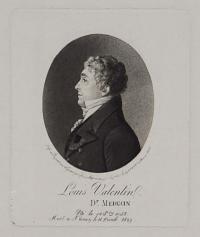
Louis Valentin. Dr. Medecin / Né le 14 8bre 1758 / Mort a Nancy le 11 Fevrier 1829
Dess au Physionotrace et gravé par Quenedey rue des petits Champs No.15 a Paris 1816
Etching and aquatint with large margins, platemark 115 x 95mm (4½ x 3¾"). Late impression.
French doctor Louis Valentin. This print was made by Edme Quénedey (1756 - 1830) during the sitter's lifetime and reissued with addition text after his death. Quenedey, a miniature painter and engraver, made much use of the physionotrace, a mechanised drawing instrument that could reproduce the outline profile of a portrait. It was invented by Gilles-Louis Chretien, who engraved Quenedey’s portraits from 1787 to 1789, in 1786. Chretien and Quenedey founded a very successful portrait studio in Paris together in 1788. Between 1786 – c.1810 there were only two studios in Paris which produced a relatively small number of physionotrace engravings. Consequently very few of these intriguing portraits are preserved today. Because of their origins and the realism physionotrace portraits have, they can be seen as true photo-graphic objects and are therefore classified as a forerunner of photography.
[Ref: 35221] £120.00
(£144.00 incl.VAT)
<<< Previous 1 Next >>>





![[Antonio] Sacchini.](img-thumbnail/jpegs/62403.jpg)

